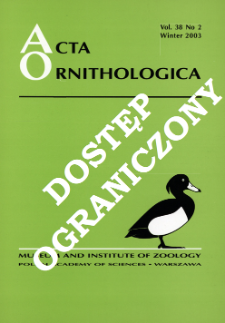- Search in all Repository
- Literature and maps
- Archeology
- Mills database
- Natural sciences
Advanced search
Advanced search
Advanced search
Advanced search
Advanced search

Object
Title: Movement patterns of adult laughing gulls Larus atricilla during the nesting season
Subtitle:
Acta Ornithologica, vol. 38, no. 1 ; Przemieszczenia dorosłych mew karaibskich w okresie lęgowym ; Laughing gull movement patterns
Contributor:
Polska Akademia Nauk. Muzeum i Instytut Zoologii
Publisher:
Place of publishing:
Description:
Bibliogr. s. 23-24 ; S. [15]-25 : il. ; 27 cm ; Streszcz. pol. Nazwy taksonów także w jęz. łac.
Type of object:
Abstract:
The foraging behavior of birds is often influenced by the development and dietary needs of their young. Laughing Gulls in New Jersey, USA, nest in highly productive salt marshes but adults commonly forage at inland sites when they have young in the nest. I monitored movements of individual Laughing Gulls using color-marking, banding and radio-telemetry combined with land-based and aerial surveys. I found that breeding adults were highly mobile and commonly flew inland to forage. Color-marked individuals were observed a mean of 16.6 km and a median of 11.0 km from the colony. Radio-tagged birds were located as far as 40 km inland. Laughing Gulls showed foraging site tenacity both within a given year and from year to year. Radio-tagged adults made as many as 11 foraging trips from the colony per day during both diurnal and nocturnal periods. Activity at the colony peaked during late evening and morning hours. Furthermore, Laughing Gull movement patterns changed with progression of the nesting season. Gulls spent more time at the colony while incubating than during either the chick rearing or fledging periods.
Relation:
Volume:
Issue:
Start page:
End page:
Detailed Resource Type:
Format:
Resource Identifier:
Source:
MiIZ PAN, patrz sygn. czas. P.257-38-1 ; MiIZ PAN, patrz sygn. czas. P.4568-38-1 ; click here to follow the link
Language:
Rights:
Prawa zastrzeżone - dostęp ograniczony
Terms of use:
Digitizing institution:
Muzeum i Instytut Zoologii Polskiej Akademii Nauk
Original in:
Biblioteka Muzeum i Instytutu Zoologii PAN
Projects co-financed by:
Program Operacyjny Innowacyjna Gospodarka, lata 2010-2014, Priorytet 2. Infrastruktura strefy B + R ; Unia Europejska. Europejski Fundusz Rozwoju Regionalnego
Access:
Object collections:
- Digital Repository of Scientific Institutes > Partners' collections > Museum and Institute of Zoology PAS > Scientific Journals
- Digital Repository of Scientific Institutes > Partners' collections > Museum and Institute of Zoology PAS > MIZ PAN Publications > Acta Ornithologica
- Digital Repository of Scientific Institutes > Literature > Journals/Articles
Last modified:
Feb 4, 2025
In our library since:
Jun 10, 2014
Number of object content downloads / hits:
54
All available object's versions:
https://rcin.org.pl./publication/55588
Show description in RDF format:
Show description in RDFa format:
Show description in OAI-PMH format:
| Edition name | Date |
|---|---|
| Movement patterns of adult laughing gulls Larus atricilla during the nesting season / Dosch, Jerald J. | Feb 4, 2025 |
Objects Similar
Vīksne, Jānis (1936– )
Kuročkin, Evgenij Nikolaevič
Birkenmajer, Krzysztof (1929– )
Wesołowski, Tomasz (1950– ) Głażewska, Ewa Głażewski, Lech Hejnowicz, Ewa Nawrocka, Beata Nawrocki, Przemysław Okońska, Krystyna
Luniak, Maciej (1936– )
Wesołowski, Tomasz (1950– ) Głażewska, Ewa Głażewski, Lech Nawrocka, Beata Nawrocki, Przemysław Okońska, Krystyna
Stempniewicz, Lech (1949– )
Migula, Paweł Augustyniak, Maria Szymczyk, Artur Kowalczyk, Katarzyna

 INSTYTUT ARCHEOLOGII I ETNOLOGII POLSKIEJ AKADEMII NAUK
INSTYTUT ARCHEOLOGII I ETNOLOGII POLSKIEJ AKADEMII NAUK
 INSTYTUT BADAŃ LITERACKICH POLSKIEJ AKADEMII NAUK
INSTYTUT BADAŃ LITERACKICH POLSKIEJ AKADEMII NAUK
 INSTYTUT BADAWCZY LEŚNICTWA
INSTYTUT BADAWCZY LEŚNICTWA
 INSTYTUT BIOLOGII DOŚWIADCZALNEJ IM. MARCELEGO NENCKIEGO POLSKIEJ AKADEMII NAUK
INSTYTUT BIOLOGII DOŚWIADCZALNEJ IM. MARCELEGO NENCKIEGO POLSKIEJ AKADEMII NAUK
 INSTYTUT BIOLOGII SSAKÓW POLSKIEJ AKADEMII NAUK
INSTYTUT BIOLOGII SSAKÓW POLSKIEJ AKADEMII NAUK
 INSTYTUT CHEMII FIZYCZNEJ PAN
INSTYTUT CHEMII FIZYCZNEJ PAN
 INSTYTUT CHEMII ORGANICZNEJ PAN
INSTYTUT CHEMII ORGANICZNEJ PAN
 INSTYTUT FILOZOFII I SOCJOLOGII PAN
INSTYTUT FILOZOFII I SOCJOLOGII PAN
 INSTYTUT GEOGRAFII I PRZESTRZENNEGO ZAGOSPODAROWANIA PAN
INSTYTUT GEOGRAFII I PRZESTRZENNEGO ZAGOSPODAROWANIA PAN
 INSTYTUT HISTORII im. TADEUSZA MANTEUFFLA POLSKIEJ AKADEMII NAUK
INSTYTUT HISTORII im. TADEUSZA MANTEUFFLA POLSKIEJ AKADEMII NAUK
 INSTYTUT JĘZYKA POLSKIEGO POLSKIEJ AKADEMII NAUK
INSTYTUT JĘZYKA POLSKIEGO POLSKIEJ AKADEMII NAUK
 INSTYTUT MATEMATYCZNY PAN
INSTYTUT MATEMATYCZNY PAN
 INSTYTUT MEDYCYNY DOŚWIADCZALNEJ I KLINICZNEJ IM.MIROSŁAWA MOSSAKOWSKIEGO POLSKIEJ AKADEMII NAUK
INSTYTUT MEDYCYNY DOŚWIADCZALNEJ I KLINICZNEJ IM.MIROSŁAWA MOSSAKOWSKIEGO POLSKIEJ AKADEMII NAUK
 INSTYTUT PODSTAWOWYCH PROBLEMÓW TECHNIKI PAN
INSTYTUT PODSTAWOWYCH PROBLEMÓW TECHNIKI PAN
 INSTYTUT SLAWISTYKI PAN
INSTYTUT SLAWISTYKI PAN
 SIEĆ BADAWCZA ŁUKASIEWICZ - INSTYTUT TECHNOLOGII MATERIAŁÓW ELEKTRONICZNYCH
SIEĆ BADAWCZA ŁUKASIEWICZ - INSTYTUT TECHNOLOGII MATERIAŁÓW ELEKTRONICZNYCH
 MUZEUM I INSTYTUT ZOOLOGII POLSKIEJ AKADEMII NAUK
MUZEUM I INSTYTUT ZOOLOGII POLSKIEJ AKADEMII NAUK
 INSTYTUT BADAŃ SYSTEMOWYCH PAN
INSTYTUT BADAŃ SYSTEMOWYCH PAN
 INSTYTUT BOTANIKI IM. WŁADYSŁAWA SZAFERA POLSKIEJ AKADEMII NAUK
INSTYTUT BOTANIKI IM. WŁADYSŁAWA SZAFERA POLSKIEJ AKADEMII NAUK




































